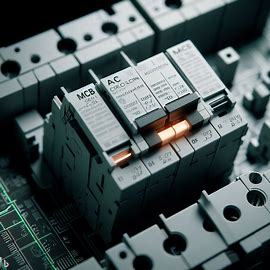Don't wanna be here? Send us removal request.
Text
AC Miniature Circuit Breakers: The First Line of Defense
In the realm of electrical circuits and safety, Miniature Circuit Breakers (MCBs) play an indispensable role. Among the various types of MCBs, the AC MCB holds a prominent position. This article delves into the world of AC MCBs, shedding light on their significance, functionality, and applications in electrical systems.


The Basics of AC MCBs
AC MCBs, short for Alternating Current Miniature Circuit Breakers, are crucial components in electrical distribution boards. Their primary function is to protect electrical circuits and appliances from overcurrent, which can lead to damage, electrical fires, or even hazards to human life.
Key Features and Components
AC MCBs are designed with specific features that make them suitable for AC circuits. Here are some essential features and components:
Bimetallic Strip:
AC MCBs are equipped with a bimetallic strip that bends when exposed to excessive current. This bending action triggers the tripping mechanism.
Tripping Mechanism:
The tripping mechanism is responsible for disconnecting the circuit when an overcurrent occurs. It operates quickly to prevent any damage or hazards.
Calibration:
AC MCBs are precisely calibrated to respond to overcurrents that typically occur in AC circuits. They are not suitable for DC circuits due to differences in current behavior.
Rated Current:
AC MCBs are available in various rated current values, allowing users to select the appropriate MCB based on the load's requirements.
Functionality
The primary function of an AC MCB is to provide overcurrent protection by interrupting the flow of electricity when it exceeds safe levels. This is vital for preventing electrical fires and protecting both equipment and personnel.
When an overload or short circuit occurs in an AC circuit, the bimetallic strip heats up, causing it to bend and trip the mechanism. This action opens the circuit, effectively cutting off the power supply.
Applications
AC MCBs find application in a wide range of electrical systems and appliances, including:
Residential Electrical Panels:
They are commonly used in homes to protect circuits serving lights, outlets, and appliances.
Commercial Buildings:
AC MCBs are crucial components in commercial electrical distribution boards, safeguarding circuits powering offices, equipment, and lighting.
Industrial Facilities:
In industrial settings, AC MCBs protect circuits associated with heavy machinery, manufacturing processes, and power distribution.
Hospitals and Healthcare Facilities:
Ensuring the reliability of electrical systems in healthcare settings is critical. AC MCBs are used to protect medical equipment and maintain the continuity of life-saving devices.
Data Centers:
Data centers rely on uninterrupted power supplies. AC MCBs play a key role in protecting the sensitive electronic equipment that keeps data centers operational.
Conclusion
AC MCBs are vital components in electrical systems, serving as the first line of defense against overcurrents and electrical faults. Their ability to quickly interrupt the circuit when needed ensures the safety of both people and equipment.
Understanding the role and importance of AC MCBs is essential for anyone involved in electrical system design, maintenance, or troubleshooting, as they form a critical part of electrical safety and reliability.
1 note
·
View note
Text
#DataOps Platform#Data Collaboration#Data Security#Data Workflow Automation#Cross-Functional Collaboration#DataOps Tools#Data Insights#Data Quality#DevOps#Data Pipelines
1 note
·
View note
Text
Bionic Ear
A Bionic Ear is an electronic device, sometimes known as a cochlear implant, that helps people with severe or profound hearing loss hear again by stimulating the auditory nerve. The industry that creates, sells, and distributes cochlear implants is known as the "bionic ear market," and it has been developing as a result of breakthroughs in technology, an increase in the prevalence of hearing loss, and more public knowledge of their advantages.

1 note
·
View note
Text
Camping equipment
Camping equipment refers to the various tools, gear, and supplies that are essential for outdoor camping activities. Whether you're embarking on a weekend getaway or a longer expedition, having the right camping equipment can greatly enhance your outdoor experience and ensure your safety and comfort in the wilderness.
The Asia Pacific market dominated the Global Camping Equipment Market by Region in 2022; thereby, achieving a market value of $13.8 billion by 2029. The Europe market is estimated to grow at a CAGR of 7.2% during (2023 - 2029).

2 notes
·
View notes